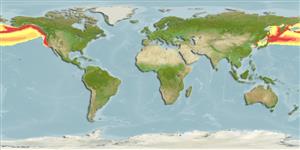Common names from other countries
Environment: milieu / climate zone / depth range / distribution range
Ekologi
marina batypelagisk; djupintervall 0 - 3383 m (Ref. 50550), usually 0 - 238 m (Ref. 6885). Temperate; 66°N - 34°N
North Pacific: Sea of Okhotsk Pacific southeast of Hokkaido to southeastern Kamchatka and Bering Sea, Alaska to California.
Size / Vikt / Age
Maturity: Lm ? range ? - ? cm
Max length : 6.5 cm SL hane/ej könsbestämd; (Ref. 559)
Short description
Bestämningsnycklar | Morfologi | Morfometri
Taggstrålar i ryggfenan (totalt) : 0; Mjukstrålar i ryggfenan (totalt) : 53; Taggstrålar i analfenan: 0; Mjukstrålar i analfenan: 48. Caudal appears truncate but may be pointed.
Has been taken from stagnant bottoms (Ref. 6885). Minimum depth from Ref. 006885.
Life cycle and mating behavior
Maturities | Reproduktion | Spawnings | Egg(s) | Fecundities | Larver
Robins, C.R., R.M. Bailey, C.E. Bond, J.R. Brooker, E.A. Lachner, R.N. Lea and W.B. Scott, 1991. Common and scientific names of fishes from the United States and Canada. Am. Fish. Soc. Spec. Publ. (20):183 p. (Ref. 3814)
IUCN Red List Status (Ref. 130435)
CITES (Ref. 128078)
Not Evaluated
Threat to humans
Harmless
Human uses
Verktyg
Special reports
Download XML
Internet-källor
Estimates based on models
Preferred temperature (Ref.
115969): 2.1 - 13.9, mean 6.7 (based on 1605 cells).
Phylogenetic diversity index (Ref.
82804): PD
50 = 1.0000 [Uniqueness, from 0.5 = low to 2.0 = high].
Bayesian length-weight: a=0.00525 (0.00237 - 0.01161), b=3.15 (2.96 - 3.34), in cm Total Length, based on LWR estimates for this (Sub)family-body shape (Ref.
93245).
Trofisk nivå (Ref.
69278): 3.3 ±0.5 se; based on size and trophs of closest relatives
Resiliens (Ref.
120179): Hög, lägsta populationsfördubblingstid mindre än 15 månader (Preliminary K or Fecundity.).
Fishing Vulnerability (Ref.
59153): Low vulnerability (10 of 100).
